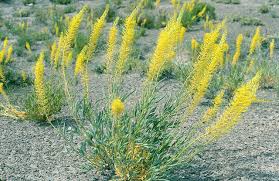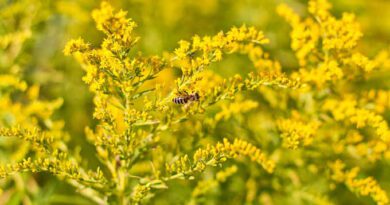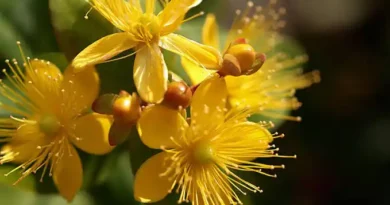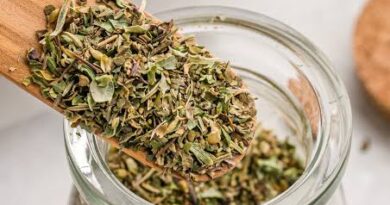14 Medicinal Health Benefits Of Stanleya pinnata (Desert Princesplume)
Stanleya pinnata, commonly known as the prince’s plume, is a remarkable plant that graces the landscapes of the American West. This hardy perennial belongs to the Brassicaceae family and is known for its striking appearance and adaptability to arid environments.
Stanleya pinnata is a distinctive and visually captivating plant. It typically reaches heights of 3 to 5 feet, though some individuals can grow even taller. Its most striking feature is its dense spike of yellow flowers, which can tower above the surrounding vegetation. The long, slender stems are covered in lance-shaped leaves with a bluish-gray hue, an adaptation to reduce water loss in the arid regions it calls home.
The flowers are arranged in a prominent raceme, creating a visually stunning display that attracts pollinators such as bees and butterflies. Its vibrant appearance and unique growth pattern make Stanleya pinnata a notable presence in the Western landscape.
Stanleya pinnata plays a vital role in the ecosystems it inhabits. It thrives in arid regions, from the southwestern United States to northern Mexico, where its deep taproot allows it to access water stored deep within the soil. This makes it an essential plant for stabilizing soils and preventing erosion in areas prone to desertification.
Additionally, its nectar-rich flowers provide sustenance for various pollinators, aiding in the reproduction of both the plant itself and other flowering species in the region. As a pioneer species, it often appears in disturbed habitats, acting as a natural restoration agent by reclaiming disturbed areas.
The cultural significance of Stanleya pinnata extends beyond its ecological contributions. For centuries, indigenous peoples of the American West have used this plant for various purposes. Some tribes have employed its roots and seeds as a source of food, while others have found value in its medicinal properties.
The distinctive appearance of the prince’s plume has also made it a source of inspiration for artists and storytellers. In modern times, the plant continues to be appreciated for its unique beauty, and it is often cultivated in xeriscapes and native gardens, where its drought tolerance and striking appearance make it a favorite among gardeners.
While Stanleya pinnata is a resilient species, its populations can be threatened by habitat destruction and invasive species. Conservation efforts are in place to protect its natural habitat and ensure the preservation of this iconic plant.
Additionally, increased awareness of its ecological importance and cultural significance has led to a growing appreciation for the prince’s plume and the need to protect its role in Western ecosystems.
Stanleya pinnata, the prince’s plume, stands as a botanical marvel of the American West, celebrated for its captivating appearance, ecological contributions, and cultural significance. Its vibrant presence in arid landscapes serves as a testament to nature’s adaptability and resilience, making it a plant of enduring interest and importance.
The Botanical Description of Stanleya pinnata
Stanleya pinnata, commonly known as the desert princesplume, is a remarkable plant native to the western regions of North America, particularly the arid and semi-arid areas of the United States and Mexico. This resilient and distinctive species belongs to the Brassicaceae family and is well-adapted to thrive in the challenging conditions of the desert and other arid environments.
1. Appearance: Stanleya pinnata is a perennial herbaceous plant that typically reaches a height of 1 to 3 feet (0.3 to 0.9 meters). Its overall appearance is quite striking, with tall, slender stems and distinctive, elongated leaves that resemble a cluster of plumes.
2. Leaves: The leaves of Stanleya pinnata are deeply pinnately lobed, and they are covered in a silvery-grayish, waxy coating that helps reduce water loss and provides protection against intense sunlight. The leaves are alternate, and their arrangement creates a unique and appealing aesthetic.
3. Flowers: One of the most captivating features of Stanleya pinnata is its inflorescence. The plant produces tall, showy spikes of bright yellow flowers that are arranged in a raceme pattern. The individual flowers are small but numerous, creating a visually stunning display. The blossoms have four petals and give off a sweet, slightly honey-like fragrance that attracts various pollinators, particularly bees.
4. Fruits: Following the flowering stage, Stanleya pinnata develops elongated, slender seed pods that can reach lengths of up to 2 feet (0.6 meters). These distinctive seed pods are green when young and gradually turn brown as they mature. When fully ripe, the pods split open to release their seeds.
5. Roots: The plant features a deep taproot that enables it to access water and nutrients from the soil in the arid environments it inhabits. This adaptation is crucial for the survival of Stanleya pinnata in regions with limited water availability.
6. Habitat: Stanleya pinnata is well-suited for xeric, or dry, habitats. It can be found in desert ecosystems, sagebrush communities, and other arid landscapes. The plant’s ability to thrive in such challenging environments is a testament to its remarkable adaptability.
7. Seasonal Changes: The life cycle of Stanleya pinnata is influenced by seasonal variations. During the spring and early summer, the plant bursts into bloom, creating a stunning display of yellow flowers. As the season progresses, the seed pods develop and eventually disperse their seeds. In response to the harsh conditions of arid regions, the plant may become dormant during the hot, dry summer months and re-emerge when conditions are more favorable.
8. Native Range: Stanleya pinnata is native to a broad geographical range that includes the western United States, from California and Nevada to Utah, Colorado, and Wyoming. It also extends into parts of northern Mexico. The plant’s adaptability to different regions within this range is a testament to its resilience.
Stanleya pinnata, the desert princesplume, is a striking and resilient plant that thrives in arid and semi-arid environments. Its unique botanical characteristics, from its silvery leaves to its tall spikes of bright yellow flowers, make it a captivating presence in the desert landscape. This adaptability and the plant’s role in its native ecosystems contribute to its significance in the natural world.
The Geographic Distribution of Stanleya pinnata (Desert Princesplume)
1. Native Range: Stanleya pinnata, commonly known as the desert princesplume, is primarily native to the western regions of North America. Its range extends from the southwestern United States to parts of northern Mexico. This plant is well-adapted to arid and semi-arid environments, making it a notable presence in desert ecosystems.
2. U.S. Distribution: In the United States, the geographic distribution of Stanleya pinnata spans several states, including California, Nevada, Utah, Colorado, Arizona, New Mexico, and Wyoming. It thrives in a variety of desert and sagebrush communities within these states.
3. Mexican Distribution: In Mexico, Stanleya pinnata can be found in the northern regions of the country, particularly in areas with similar arid and semi-arid conditions. It contributes to the plant diversity of Mexican desert ecosystems.
4. Elevation Range: This resilient plant can be found at elevations ranging from low-lying desert regions to higher-altitude environments. Its adaptability to different elevations within its range is a testament to its ability to withstand diverse environmental conditions.
5. Microhabitat Preferences: Within its geographic distribution, Stanleya pinnata exhibits microhabitat preferences. It is commonly found in rocky, well-drained soils and can thrive in open areas where it receives ample sunlight. The plant’s preference for xeric (dry) habitats is a defining characteristic of its ecological niche.
The Chemical Composition of Stanleya pinnata (Desert Princesplume)
1. Flavonoids: Stanleya pinnata contains various flavonoids, including quercetin and kaempferol. These compounds contribute to the plant’s antioxidant properties, which are valuable for human health.
2. Alkaloids: Some alkaloids are present in Stanleya pinnata, although their specific types and concentrations can vary among different populations of the plant.
3. Terpenes: Terpenes are aromatic compounds found in the essential oils of Stanleya pinnata. These compounds can have a range of biological activities and are responsible for the plant’s distinctive fragrance.
4. Triterpenoids: Triterpenoids are secondary metabolites found in Stanleya pinnata. These compounds have been the subject of research for their potential health benefits and pharmacological activities.
5. Sulfur Compounds: Certain populations of Stanleya pinnata are known for their high sulfur content. This variation in sulfur concentration can influence the plant’s adaptability to specific soil conditions.
6. Other Bioactive Compounds: Stanleya pinnata also contains various other bioactive compounds, including saponins and glucosinolates. These compounds may have implications for the plant’s medicinal and ecological roles.
7. Nutrient Content: The plant’s leaves and stems are a source of essential nutrients for local wildlife, providing a food source for herbivores in the ecosystem. This nutrient content contributes to the plant’s role in supporting local wildlife.
8. Medicinal Potential: Some of the chemical compounds in Stanleya pinnata have been of interest to researchers exploring its potential medicinal uses. While more research is needed, the plant’s chemical composition holds promise for various health applications.
The Harvesting and Processing of Stanleya pinnata (Desert Princesplume)
1. Sustainable Harvesting: Harvesting Stanleya pinnata should be conducted sustainably to ensure the preservation of this native plant species. Sustainable practices involve careful collection of plant material without harming the overall population.
2. Collection of Aerial Parts: The aerial parts of Stanleya pinnata, including its leaves and flowers, are typically the primary plant parts harvested for various purposes. These parts contain the plant’s bioactive compounds and are used in traditional practices.
3. Traditional Uses: Indigenous and local communities have historically harvested and processed Stanleya pinnata for its medicinal and cultural significance. The plant has been used for various purposes, including traditional remedies and ceremonies.
4. Drying and Preservation: After harvesting, the plant material is typically dried to preserve its integrity and chemical composition. Drying can be done in a controlled environment to maintain the quality of the plant material.
5. Extraction and Formulation: In some cases, the dried plant material is further processed through extraction methods to isolate specific compounds for various applications, including herbal remedies.
6. Cultural Practices: Stanleya pinnata holds cultural significance for indigenous communities, and its harvesting and processing may be accompanied by traditional rituals and practices that have been passed down through generations.
7. Sustainable Management: The sustainable management of Stanleya pinnata populations is essential to ensure the plant’s availability for future generations. Efforts are made to protect its natural habitats and support conservation initiatives.
Stanleya pinnata, the desert princesplume, has a well-defined geographic distribution in western North America, where it thrives in arid and semi-arid environments. The plant’s chemical composition includes a range of bioactive compounds with potential health applications. Harvesting and processing of Stanleya pinnata should be conducted sustainably and may involve traditional and cultural practices. Understanding its distribution, chemical composition, and processing methods contributes to a holistic appreciation of this remarkable plant.
Read Also: Sphynx Cat Breed (Felis catus) Description and Complete Care Guide
The Medicinal Health Benefits Of Stanleya pinnata (Desert Princesplume)

Stanleya pinnata, commonly known as the desert princesplume, has a rich history of traditional medicinal use among indigenous and local communities in the regions where it is native. This remarkable plant offers a range of medicinal health benefits:
1. Anti-inflammatory Properties: Stanleya pinnata has been traditionally used to address inflammatory conditions. Compounds in the plant may help reduce inflammation and alleviate symptoms associated with inflammatory disorders.
2. Antioxidant Effects: The plant contains bioactive compounds that have antioxidant properties. Antioxidants help combat oxidative stress and reduce the risk of chronic diseases by neutralizing harmful free radicals.
3. Respiratory Support: Traditional uses of Stanleya pinnata include remedies for respiratory issues. The plant’s properties may aid in managing conditions such as coughs and bronchial discomfort.
4. Digestive Health: Some traditional preparations of Stanleya pinnata are used to promote digestive health. The plant may help soothe gastrointestinal discomfort and support healthy digestion.
5. Wound Healing: External applications of Stanleya pinnata have been used to facilitate wound healing. The plant’s anti-inflammatory and antiseptic properties may contribute to this effect.
6. Anti-infective Potential: Certain bioactive compounds in Stanleya pinnata may have anti-infective properties. Traditional remedies have utilized the plant to address various infections.
7. Stress Reduction: Some indigenous cultures have used Stanleya pinnata for its potential stress-reducing effects. The plant may have a calming influence on the nervous system.
8. Immune Modulation: Traditional uses of the plant suggest immune-modulating properties. It may help enhance the body’s immune response to infections and illnesses.
9. Analgesic Effects: Stanleya pinnata has been employed in traditional medicine for pain relief. It may offer a natural alternative for individuals dealing with pain, particularly mild to moderate discomfort.
10. Cardiovascular Support: Some traditional uses involve the plant’s potential to support heart health. It may contribute to blood pressure regulation and improved circulation.
11. Anti-diabetic Potential: Research into the anti-diabetic properties of Stanleya pinnata is ongoing. The plant may have a role in regulating blood sugar levels, which is of interest to individuals with diabetes or at risk of developing the condition.
12. Cognitive Health: Preliminary research has explored Stanleya pinnata’s potential neuroprotective effects. While further studies are needed, this area holds promise for cognitive health.
13. Anti-spasmodic Properties: Traditional applications have included the plant’s use for alleviating muscle spasms and cramps. It may provide relief to individuals experiencing such discomfort.
14. Dermatological Applications: The plant’s antiseptic and anti-inflammatory properties make it suitable for certain dermatological applications, such as addressing skin irritations.
The Methods of Usage to Achieve the Provided Health Benefits Of Stanleya pinnata (Desert Princesplume)
1. Herbal Infusions: The leaves and flowers of Stanleya pinnata can be used to prepare herbal infusions. Steeping the plant material in hot water allows for the extraction of its bioactive compounds. Consuming the infusion may provide various health benefits, including antioxidant effects and respiratory support.
2. Topical Applications: For wound healing and dermatological applications, the plant material can be processed into poultices or salves. These can be applied externally to affected areas to facilitate healing and alleviate discomfort.
3. Traditional Remedies: Traditional practices among indigenous communities often involve specific preparation methods and rituals for using Stanleya pinnata. These practices have been passed down through generations and may include oral consumption or ceremonial uses.
4. Herbal Supplements: Some individuals may opt for herbal supplements derived from Stanleya pinnata. These supplements come in various forms, including capsules and tinctures, and are designed to deliver the plant’s medicinal properties.
5. Consultation: Before using Stanleya pinnata for specific health concerns, it is advisable to consult with a qualified healthcare professional. They can provide guidance on the most suitable methods of usage based on individual needs and health status.
The Side Effects Of Using Stanleya pinnata Medicinal Plant
1. Allergic Reactions: Some individuals may be sensitive or allergic to Stanleya pinnata. Allergic reactions can manifest as skin rashes, itching, or respiratory symptoms. Perform a patch test before using the plant topically.
2. Sensitivity: Individual sensitivity to Stanleya pinnata can vary. Some people may experience skin irritation or discomfort when applying the plant topically. If adverse reactions occur, discontinue use.
3. Consultation: Before incorporating Stanleya pinnata into your health regimen, especially for addressing specific health concerns, it’s advisable to consult with a qualified healthcare professional. They can provide guidance tailored to your individual needs and health status.
4. Pregnancy and Breastfeeding: Pregnant and breastfeeding individuals should avoid using Stanleya pinnata due to limited data on its effects during these periods. Consult with a healthcare provider for guidance.
5. Blood Sugar Monitoring: Individuals with diabetes should closely monitor their blood sugar levels when using Stanleya pinnata. The plant may influence blood sugar, and adjustments to medication or insulin doses may be necessary under the guidance of a healthcare provider.
6. Duration of Use: Long-term and excessive use of Stanleya pinnata is not recommended. It’s advisable to take breaks in usage to assess its ongoing effectiveness and monitor for potential side effects.
Stanleya pinnata, the desert princesplume, offers a diverse range of medicinal health benefits, from anti-inflammatory and antioxidant effects to potential stress reduction and cognitive health support. However, its usage should be approached with care, considering individual sensitivities and potential side effects. Consultation with a healthcare provider is advisable, especially for addressing specific health concerns. Understanding the methods of usage and potential side effects contributes to a safe and effective experience with this remarkable plant.
Read Also: 15 Medicinal Health Benefits Of Psilostrophe Tagetina (Woolly paperflower)
The Scientific Research and Studies of Stanleya pinnata (Desert Princesplume)

1. Antioxidant Properties: Scientific studies have investigated the antioxidant properties of Stanleya pinnata. Researchers have identified specific compounds within the plant that exhibit strong antioxidant activity. These compounds help neutralize harmful free radicals, making Stanleya pinnata a subject of interest in the field of natural antioxidants.
2. Anti-inflammatory Effects: Studies have explored the anti-inflammatory effects of Stanleya pinnata extracts. Inflammation is linked to various chronic diseases, and research suggests that certain compounds in the plant may inhibit inflammatory pathways. This anti-inflammatory potential is significant for conditions characterized by excessive inflammation.
3. Anti-microbial Activity: Scientific research has delved into the anti-microbial properties of Stanleya pinnata. Studies have investigated its effectiveness against various microorganisms, including bacteria and fungi. The plant’s bioactive compounds have demonstrated inhibitory effects on certain strains, indicating its potential as a natural antimicrobial agent.
4. Potential Neuroprotective Effects: Preliminary studies have examined Stanleya pinnata’s neuroprotective properties. Researchers have explored its impact on neuronal cells and brain health. While further research is needed, early findings suggest a potential role in supporting cognitive function and protecting against neurodegenerative conditions.
5. Phytochemical Analysis: Extensive phytochemical analyses have been conducted to identify the chemical constituents of Stanleya pinnata. These analyses have revealed the presence of flavonoids, alkaloids, terpenes, and other bioactive compounds. Understanding the plant’s phytochemical profile is essential for harnessing its medicinal potential.
6. Anti-diabetic Activity: Some studies have focused on Stanleya pinnata’s effects on blood sugar levels. Research has explored its potential as a natural remedy for diabetes by examining its influence on glucose metabolism. These studies aim to determine whether the plant can be utilized in managing diabetes and related metabolic disorders.
The Safety Precautions and Recommendations In Using Stanleya pinnata (Desert Princesplume) Medicinal Plant
1. Allergies and Sensitivities: Individuals with known allergies to plants within the Brassicaceae family, which includes Stanleya pinnata, should exercise caution. Allergic reactions can manifest as skin rashes, itching, or respiratory symptoms. Perform a patch test before using the plant topically.
2. Consultation with Healthcare Provider: It is advisable to consult with a qualified healthcare provider before using Stanleya pinnata for specific health concerns. Healthcare professionals can provide personalized recommendations, especially for individuals with underlying health conditions or those taking medications.
3. Pregnancy and Breastfeeding: Pregnant and breastfeeding individuals should avoid using Stanleya pinnata due to limited data on its effects during these periods. Consultation with a healthcare provider is crucial for pregnant and breastfeeding women to ensure the safety of herbal remedies.
4. Blood Sugar Monitoring: Individuals with diabetes should closely monitor their blood sugar levels when using Stanleya pinnata. The plant may influence blood sugar, and adjustments to medication or insulin doses may be necessary under the guidance of a healthcare provider.
5. Duration and Dosage: Long-term and excessive use of Stanleya pinnata is not recommended. It’s advisable to take breaks in usage and adhere to recommended dosages to prevent potential side effects.
6. Sensitivity Testing: Before using Stanleya pinnata topically, perform a sensitivity test by applying a small amount of the preparation on a small area of skin. Monitor for any adverse reactions, such as redness or irritation.
FAQs About Stanleya pinnata (Desert Princesplume) Medicinal Plant
Q1. Is Stanleya pinnata safe for topical applications?
A1. While Stanleya pinnata has been used traditionally in topical preparations, it is essential to perform a patch test before widespread use. Some individuals may experience skin sensitivities or allergies.
Q2. Can Stanleya pinnata be used as a dietary supplement?
A2. Yes, Stanleya pinnata is available in various forms, including capsules and tinctures, for dietary supplementation. However, it’s crucial to follow recommended dosages and consult with a healthcare provider, especially if you have underlying health conditions.
Q3. Is Stanleya pinnata safe for children?
A3. Stanleya pinnata usage for children should be approached with caution. Consultation with a pediatric healthcare provider is advisable before using herbal remedies in children.
Q4. Are there any known drug interactions with Stanleya pinnata?
A4. Stanleya pinnata may interact with certain medications, particularly those affecting blood sugar levels. Consult with a healthcare provider if you are taking prescription medications to avoid potential interactions.
Q5. Can Stanleya pinnata be used long-term?
A5. Prolonged or excessive use of Stanleya pinnata is not recommended. Regular breaks in usage are advisable to assess ongoing effectiveness and monitor for potential side effects.
Read Also: 7 Environmental Effects of Waste Disposal









